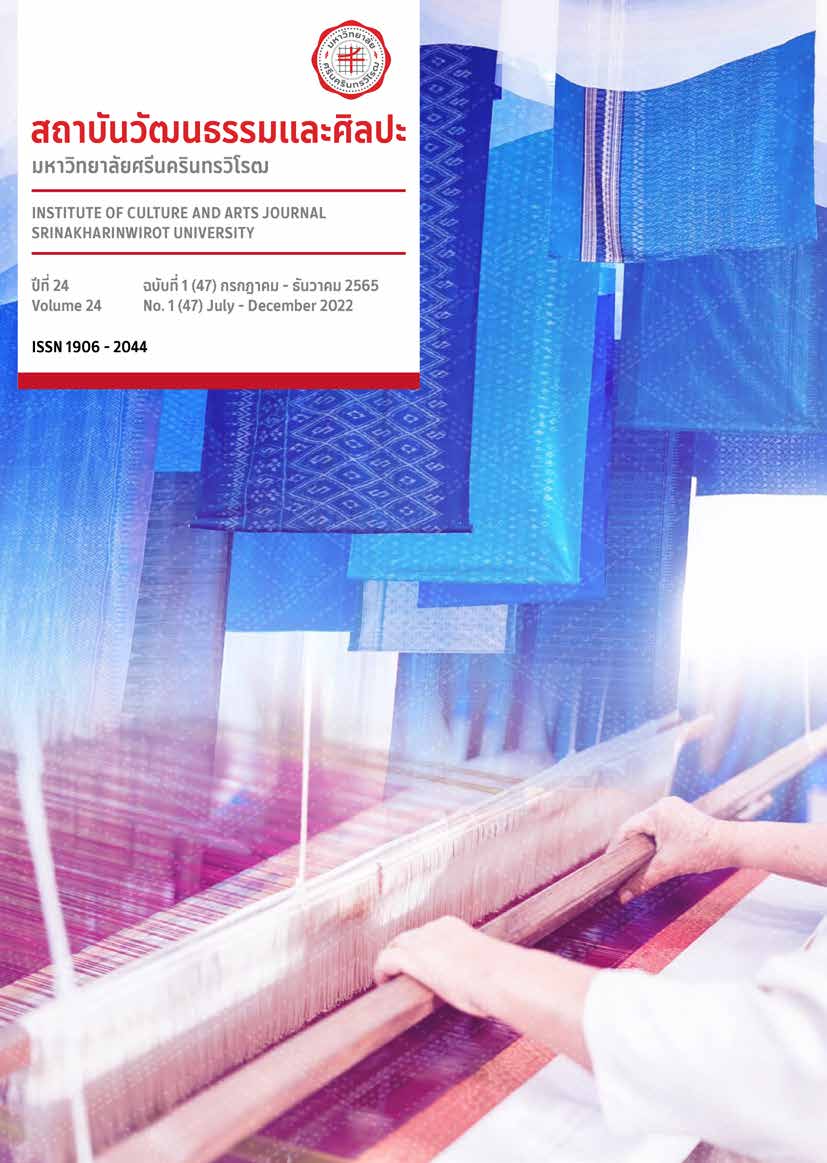The Development of Framework of Product Design for Creative Tourism with BCG Guideline
Keywords:
Design for Tourism, Product Design, Creative TourismAbstract
The research was the development and test of the application of BCG, the sustainable economic model focusing on Bio Economy, Circular Economy and Green Economy. The research has aimed for the development of framework on product design for tourism according to BCG, and to apply and tests the BCG framework by designing the product for 10 creative tourism destinations in the provinces of Chainat, Singhburi and Lopburi. The framework started from preliminary concept by reviewing documents and collecting data using recording, photographing, interviewing and focus group techniques in the area of fieldworks. Then, the information was analyzed together with the tourism activity plan and local resources. The output was the design of the souvenirs, the gifts and the product that enhanced the creative tourism experience, which those products were created from the local resources, skills and stories in the communities of destinations. The prototypes have been well accepted from the preference test with the tourism experts and the managements and leaders of the communities. The framework of product design process according to BCG from this research was developed, refined and concluded as the BCG and Creative Tourism Benefit to Community Table.
Downloads
References
กรมวิชาการ กระทรวงศึกษาธิการ. (2542). สาระและมาตรฐานการเรียนรู้กลุ่มสาระการงาน อาชีพ และเทคโนโลยี หลักสูตรการศึกษาขั้นพื้นฐาน พุทธศักราช 2544. กรุงเทพฯ: โรงพิมพ์องค์กรการรับส่งสินค้าและพัสดุภัณฑ์.
กระทรวงการอุดมศึกษา วิทยาศาสตร์ วิจัยและนวัตกรรม. (2562). ข้อเสนอ BCG in Action: The New Sustainable Growth Engine โมเดลเศรษฐกิจสู่การพัฒนาที่ยั่งยืน. สืบค้นเมื่อวันที่ 25 พฤษภาคม 2564, จาก https://www.nxpo.or.th/th/bcg-economy/
กระทรวงการท่องเที่ยวและกีฬา. (2556). การทองเที่ยวเชิงสรางสรรค์ สัมผัสภูมิปัญญาท้องถิ่น. สืบค้นเมื่อวันที่ 25 พฤษภาคม 2564, จาก http://www.thaicreativetourism.com/detail_tour.php?id=1.
กรมการท่องเที่ยว. (2560). แผนยุทธศาสตร์การพัฒนาแหล่งท่องเที่ยวของประเทศ พ.ศ. 2560 – 2564. กรุงเทพฯ: กรมการท่องเทียว กระทรวงการท่องเที่ยวและกีฬา.ชัยธวัช ทองอินทร์, 2549.
นุชนารถ รัตนสุวงศ์ชัย, อรช กระแสอินทร์ และภูริวัจน์ เดชอุ่ม. (2560). Local Neo SME การพัฒนาธุรกิจท่องเที่ยวเชิงสร้างสรรค์. กรุงเทพฯ: กระทรวงมหาดไทย. สถาบันวิจัยเพื่อพัฒนาประเทศไทย.
ประชาคมวิจัยด้านเศรษฐกิจชีวภาพ เศรษฐกิจหมุนเวียนและเศรษฐกิจสีเขียว. (2561). สมุดปกขาว BCG in Action. สืบค้นเมื่อวันที่ 25 พฤษภาคม 2564, จาก https://www.nxpo.or.th/th/bcg-economy/
สยามล เทพทา. (2561). การพัฒนาสิ่งแวดล้อมสรรค์สร้างและการเพิ่มคุณค่าของแหล่งท่องเที่ยวที่เป็นภาพลักษณ์ของจังหวัดชัยนาท. วารสารวิชาการท่องเที่ยวไทยนานาชาติ. 14(2). 76-93.
สุดแดน วิสุทธิลักษณ์, พิเชฐ สายพันธ์, อรอุมา เตพละกุล และ ธีระ สินเดชารักษ์. (2556). การท่องเที่ยวเชิงสร้างสรรค์ Creative Tourism Thailand. กรุงเทพฯ: องค์การบริหารการพัฒนาพื้นที่พิเศษเพื่อการท่องเที่ยวอย่างยั่งยืน (องค์การมหาชน).
อรช กระแสอินทร์, นุชนารถ รัตนสุวงศ์ชัย และ จริยา สุพรรณ. (2564). รายงานการวิจัยเรื่องการพัฒนาการท่องเที่ยวเชิงสร้างสรรค์ของจังหวัดชัยนาท จังหวัดชัยสิงห์บุรี และจังหวัดลพบุรี. หน่วยบริหารและจัดการทุนด้านการเพิ่มความสามารถในการแข่งขันของประเทศ (บพข.).
อรช กระแสอินทร์, เพกา เสนาะเมือง, นันทชัย ไตรรัตน์วงศ์ และ นภาวดี โรจนธรรม. (2564). รายงานโครงการวิจัยเรื่องการสร้างสรรค์และออกแบบผลิตภัณฑ์และสิ่งแวดล้อมสรรค์สร้างเพื่อการท่องเที่ยวเชิงสร้างสรรค์. หน่วยบริหารและจัดการทุนด้านการเพิ่มความสามารถในการแข่งขันของประเทศ (บพข.).
Ammirato, S., Felicetti, A.M. and Dell Gal, M. (2015). Rethinking Tourism Destinations: Collaborative Network Models for the Tourist 2.0. International Journal Knowledge Based Development. 6(3): 178 – 201. Retrieved May 11, 2018 from https://www.researchgatenet/publication/277718523 _Rethinking_tourism_destinations_Collaborative_network_models_for_the_tourist_20.
Beckman, J. (1999). The Current State of Knowledge Management. In Jay Liebowitz (Ed.), Knowledge Management Handbook (p.1-5). Boca Raton: CRC Press.
Binkhorst, E. (2006). The co-creation tourism experience. In The XV International in Tourism & Leisure Symposium 2006, Barcelona, Spain. Retrieved 15 June 2020 from https://www.recercat.cat/ bitstream/ handle/2072/443869/Binkhorst_2006_Barcelona_Cocr.pdf
Richards, G. and Raymond, C. (2000). Creative Tourism. ATLAS News 23: 16-20. Retrieved 10 April 2015 from https://www.researchgate.net/publication/254822440_ Creative_Tourism.
Richards, G. and Wilson, J. (2006). Developing Creativity in Tourist Experiences: A Solution to the Serial Reproduction of Culture. Tourism Management, 27: 1408-1413.
Šimková, Eva. (2009). Knowledge management in tourism. In Conference ICL2009 September 23 -25, 2009. Villach: Austria.
UNESCO. (2006). Towards Sustainable Strategies for Creative Tourism Discussion. In the Planning Meeting for 2008 International Conference on Creative Tourism. October 25-27, 2006 Santa Fe, New Mexico, USA.
Downloads
Published
How to Cite
Issue
Section
License
Copyright (c) 2022 Institute of Culture and Arts Journal

This work is licensed under a Creative Commons Attribution-NonCommercial-NoDerivatives 4.0 International License.
บทความทุกบทความที่ได้รับการตีพิมพ์ถือเป็นลิขสิทธิ์ของวารสารสถาบันวัฒนธรรมและศิลปะ มหาวิทยาลัยศรีนครินทรวิโรฒ


